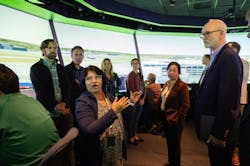NASA and Joby show off air traffic simulation tech for 'flying taxi' integration
MOUNTAIN VIEW, Calif., - The National Aeronautics and Space Administration (NASA) and its Ames Research Center in Mountain View, California, have announced that researchers are advancing the integration of air taxis and electric vertical takeoff and landing (eVTOL) vehicles into the nation's busiest airports. This development is thanks in part to a cutting-edge air traffic simulation developed by Joby Aviation in Santa Cruz, California, and the Ames Research Center.
NASA and Joby researchers recently showcased their simulation to representatives from the Federal Aviation Administration (FAA), the National Association of Air Traffic Controllers, and other stakeholders at Ames’ air traffic control simulation facility, FutureFlight Central. This two-story facility offers a 360-degree, full-scale simulation of an airport, allowing controllers, pilots, and airport personnel to test procedures and assess new technologies.
In preparation for the influx of air taxis and other passenger aircraft at airports, NASA and industry partners are collaborating with the FAA to demonstrate how innovative use of existing tools and airspace procedures can safely integrate air taxi operations into the national airspace.
The groups are also exploring potential changes to the current airspace system to accommodate a higher volume of flights. The recent air traffic management integration simulation, a collaboration between NASA and Joby, provides valuable air traffic controller data for integrating these aircraft into operations.
Within the facility, visitors witnessed eVTOL pilots navigating along NASA-developed routes at Dallas-Fort Worth International Airport and Dallas Love Field Airport. The simulation, incorporating weather conditions, live flight data, and airport operational data, demonstrated how NASA-developed air traffic control procedures and airspace concepts could significantly reduce the workload on air traffic controllers for eVTOL operations at airports.
“This simulation validates the idea that we can find a way to safely integrate these vehicles into the airspace at scale,” said NASA researcher Ken Freeman.
The human-in-the-loop simulation, involving active and retired air traffic controllers, assessed traffic schedules developed by Joby based on market analysis and future demand expectations.
NASA's preliminary analysis suggests that these procedures for operating eVTOLs could be scaled for use in other airports nationwide, reducing the workload on air traffic controllers. The complete analysis of simulation results will be published in 2024, providing new data to the FAA, commercial industry, and airports. This information aims to identify air traffic controller tools and procedures facilitating the high-tempo integration of eVTOLs into current and future airport operations. Enabling eVTOLs as a taxi service for passengers could contribute to carbon emission reduction and significantly enhance the passenger commuting experience. This initiative aligns with NASA’s Advanced Air Mobility mission, focusing on air taxi and drone research in collaboration with industry and government partners.
